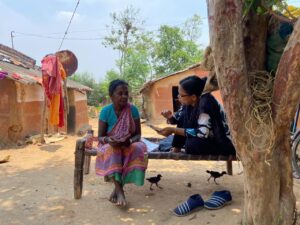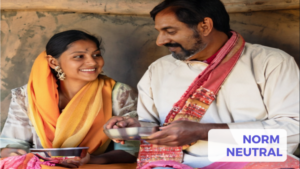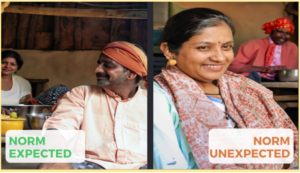GBL’s Research Associate, Avdhoot Bharati reflects on his current on-ground work in Neemrana where, along with other GBL members, he is leading the charge for our intervention which enables women’s access to paid opportunities.
While peering into our laptops outside the workshop, a group of us heard 50 women sing a folk song on ‘sakhis’ (‘friends’) inside. I asked myself what had motivated these same women to come to learn and practice crocheting; training that was part of our intervention to enable women’s participation in India’s workforce.
The compensation for the work performed under the intervention was set at current Mahatma Gandhi National Rural Employment Guarantee Act (MGNREGA) rates. We saw that, on average, overall productivity climbed steadily. We also saw a rise in output that passed quality checks. These were the crochet products they would get paid for on a weekly basis. One of our participants went from making 63 paid products in the first week to 108 in the last. Women, in general, were getting better at making the crochet products as they did more of it. We can only claim this conclusively once we wrap up this year-long intervention that will engage 500 women in Rajasthan’s Neemrana and can dig deeper into the data.
It was interesting to see the parallel evolution of their aspirations with their crochet skills. A few questions came to mind when we would see these women every day:
- Why were they continuing this work?
- What were their expectations?
- Were those expectations being met?
We slowly understood the inherent dynamism of these answers. Some women were driven to the program through knowing someone who was advocating for it. But eventually, that lent itself to some focused aspiration. In other cases, women started with one specific goal which later grew into something else. These were great teaching moments for us about not just how aspirations can evolve but also how certain preferences are socially influenced. In the early weeks, some women shared that they had bought clothes or gifts for their children from the earned income while others had goals like purchasing a smartphone or repairing their home.
Responses like these to our survey questions on expenditure made us conscious on how we even frame such questions. We faced the complexity of recording social phenomena and what constitutes a ‘fact’. How can we sincerely represent these responses? I realised conversations often reveal nodes or insights which may have gotten missed as concrete knowledge. On first glance, it was a seemingly unremarkable use of their money. Yet you could not miss the radiance on their face while talking about it. We do not know how long after receiving the paycheck did they make use of it, or if it was purely used as an unexpected resource meant for additional things or measures that were stuck due to lack of funds. But the happiness on their faces was certainly not trivial. It became apparent that their goals, the ability to meet them, and the skills they were building fuelled each other.
At the end of the intervention for the first 46 women, it was an overwhelming yes from the women when asked if they see themselves continuing to look for work opportunities. I was very enthusiastically asked if this program would continue. When our partner organization Kalaa Trust conducted a meeting to ask if women would now be interested in organizing themselves as a Self Help Group and continue producing these products, there was an unbelievably enthusiastic response. Many of these women had engaged in paid work for the first time, and to see them want to continue working was probably the most amazing evolution of aspirations that we could have hoped for.
**
GBL’s Senior Design Associate, Deborah Charles, reflects on her visit to Nimdih, a village in Jharkhand where we conducted an earlier iteration of this intervention.

We were going to be convening in Nimdih with the women who had agreed to, as part of the intervention, learn how to make artisanal handicraft products with sabai grass – a grass that was found aplenty in and around Nimdih.
On the way to the fieldwork site, the breeze hit my face and sharp turns on winding roads made my head spin. The driver’s phone rang “Jai Shri Ram” every 20 minutes. I thought about the airport security guard who asked me, “Deborah? Yeh kya naam hai? Aap Indian ho?” (“Deborah? What name is this? Are you Indian?”) while examining my obviously Indian Aadhar card. I felt the heat on my skin and thought about how different it all was compared to my hometown in the south.
We planned to interview around 15 women to understand the socio-cultural norms that surround women’s decisions to work. We were attuned to the possibility of women being biased in sharing how they feel about this. People in heavily researched areas have learned what urban researchers like to hear, especially in contexts where responding in accordance with social desirability is more likely. Prior to reaching Nimdih, we had brainstormed ways to minimize this likelihood.
One of the ways we had decided to implement was to use visual messaging in our interviews. Photo elicitation methods have been around for a long time. Our chosen method was to ask questions based on pictures we collated. I had suggested using AI to generate images. We used generative AI tools to create photographs of women and men in a rural Indian setting across three categories: norm neutral, norm expected, and norm unexpected. The process of choosing images between these norm categories allows us to tap into what women want for themselves, and contrast that to what their lives actually look like. We are able to better understand what their lives are like with respect to specific themes. The focus is on nine themes including home roles, decision-making, and finance. This would in turn give us more insight into womens’ personal belief systems regarding prevalent social norms, and what their actual behavior is like with respect to the norm in practice.

Figure 1: An example of a norm category photo for the theme of home roles (AI Generated)

Figure 2: An example of a norm category photo for the theme of home roles (AI Generated)
Despite our repeated iterations, prompts, and much to our chagrin, we could still tell that the images were AI-generated. To quote my fellow Design team member: “Why does this woman in the picture have a rupee coin for a bindi?!” That pretty much summed up our thoughts.
“Jai Shri Ram”
The driver’s loud ringtone interrupted my train of thought. He also shared his thoughts on our country’s political landscape, and how the only person he trusts is Tata ji. The industrial town is named after Jamsetji Tata, the founder of what is today a multinational conglomerate, The Tata Group. Finally, the scent of mango trees and the hoot of a distant incoming train welcomed us. We had arrived. We were also greeted by our field consultant, translators who would support us in translating the interviews to Bengali, and our exuberant point-of-contact from our then partner organization Bangla Natak, who introduced us to the women participants. She also said: “Your name is Deborah? How unique and lovely!” leaving me with a wide variety of opinions on my name in the span of one day. The women, seated under a large tree, were chatting and weaving the sabai (Chinese alpine rush) grass. The air was thick with the sounds of their children laughing, crying, and babbling, as they leaped and rolled around their working mothers. Amidst the searing heat and the dripping sweat, I enjoyed eating mangoes picked right off the ground and drinking ber (jujube) juice for the first time, courtesy of the lovely translators and field consultant. As the days passed on, I noted the lack of women on the streets after 6 PM, Tata’s name emblazoned everywhere (including on bricks!), and the overt saffronisation of the surrounding urban landscape.

Figure 3: Our field site, an ashram at Nimdih.
One of the women we interviewed was much older than the others and had consistently undertaken MGNREGA work. She described how her older sons made decisions in her house more than she did. Another woman, to my pleasant surprise, felt comfortable breastfeeding her child as she spoke to me. Another was so soft spoken that though I sat next to her, it was tough hearing her above the din of the passing trains and children. A young girl who was about to complete her inter (12th grade) distinctly occupies my mind to this day. She was ambitious, and expressed her desire to become a nurse and “stand on (her) own two feet.” She was steadfast that if her future husband did not want her to study or work, she would nevertheless insist on pursuing her passion for nursing: “I’d tell him (future husband) that I will do it. My father has struggled and made me study. I will tell him from the beginning before marriage that I will work.” What also stood out to me was the questions she asked after the interview. She asked us for more details on where we were from and how we got to where we were. She asked us how much we studied, what we learned, and what a master’s degree entailed. She told us she thought the training included learning to use computers, with a thinly veiled disappointment at the realization that it wasn’t. I saw a glimmer of hope in her eyes at making something of herself. In a world such as ours where injustice and unfairness prevail, hope remains to be one thing that pushes people forward. The flight landed, and I was whisked back into Bangalore with tedious thoughts of getting a ride back home. Rubbing my eyes to erase some of the exhaustion, a fleeting image of her flashed in my mind. I hoped she would stand on her own two feet and become a nurse someday. I hope.